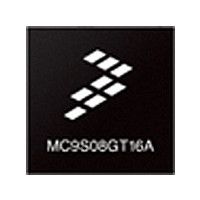MC9S08GT16CFB Freescale Semiconductor, MC9S08GT16CFB Datasheet - Page 110

MC9S08GT16CFB
Manufacturer Part Number
MC9S08GT16CFB
Description
Manufacturer
Freescale Semiconductor
Datasheet
1.MC9S08GT16CFB.pdf
(290 pages)
Specifications of MC9S08GT16CFB
Cpu Family
HCS08
Device Core Size
8b
Frequency (max)
20MHz
Interface Type
SCI/SPI
Program Memory Type
Flash
Program Memory Size
16KB
Total Internal Ram Size
1KB
# I/os (max)
36
Number Of Timers - General Purpose
4
Operating Supply Voltage (typ)
2.5/3.3V
Operating Supply Voltage (max)
3.6V
Operating Supply Voltage (min)
2.08V
On-chip Adc
8-chx10-bit
Instruction Set Architecture
CISC
Operating Temp Range
-40C to 85C
Operating Temperature Classification
Industrial
Mounting
Surface Mount
Pin Count
44
Package Type
PQFP
Lead Free Status / Rohs Status
Not Compliant
Available stocks
Company
Part Number
Manufacturer
Quantity
Price
Company:
Part Number:
MC9S08GT16CFBE
Manufacturer:
FREESCALE
Quantity:
1 831
Company:
Part Number:
MC9S08GT16CFBE
Manufacturer:
Freescale Semiconductor
Quantity:
10 000
Part Number:
MC9S08GT16CFBE
Manufacturer:
FREESCALE
Quantity:
20 000
Company:
Part Number:
MC9S08GT16CFBER
Manufacturer:
Freescale Semiconductor
Quantity:
10 000
- Current page: 110 of 290
- Download datasheet (2Mb)
Internal Clock Generator (ICG) Module
When the ICG is in either FEI or SCM mode, XCLK is turned off. Any peripherals which can use XCLK
as a clock source must not do so when the ICG is in FEI or SCM mode.
7.4
7.4.1
The section is intended to give some basic direction on which configuration a user would want to select
when initializing the ICG. For some applications, the serial communication link may dictate the accuracy
of the clock reference. For other applications, lowest power consumption may be the chief clock
consideration. Still others may have lowest cost as the primary goal. The ICG allows great flexibility in
choosing which is best for any application.
The following sections contain initialization examples for various configurations.
Important configuration information is repeated here for reference sake.
110
1. The IRG typically consumes 100 µA. The FLL and DCO typically consumes 0.5 to 2.5 mA, depending upon output frequency.
For minimum power consumption and minimum jitter, choose N and R to be as small as possible.
Bypassed
Engaged
FLL
FLL
Initialization/Application Information
Introduction
Hexadecimal values designated by a preceding $, binary values designated
by a preceding %, and decimal values have no preceding character.
FEI
4 MHz < f
Medium power (will be less than FEE if oscillator
range = high)
Good clock accuracy (After IRG is trimmed)
Lowest system cost (no external components
required)
IRG is on. DCO is on.
SCM
This mode is mainly provided for quick and reliable
system startup.
3 MHz < f
3 MHz < f
Medium power
Poor accuracy.
IRG is off. DCO is on and open loop.
Clock Reference Source = Internal
Bus
Bus
Bus
< 20 MHz.
< 5 MHz (default).
< 20 MHz (via filter bits).
Table 7-4. ICG Configuration Consideration
(1)
MC9S08GB/GT Data Sheet, Rev. 2.3
NOTE
FEE
4 MHz < f
Medium power (will be less than FEI if oscillator
range = low)
High clock accuracy
Medium/High system cost (crystal, resonator or
external clock source required)
IRG is off. DCO is on.
FBE
f
used.
Lowest power
Highest clock accuracy
Medium/High system cost (Crystal, resonator or
external clock source required)
IRG is off. DCO is off.
Bus
range <= 8 MHz when crystal or resonator is
Clock Reference Source = External
Bus
< 20 MHz
Freescale Semiconductor
Related parts for MC9S08GT16CFB
Image
Part Number
Description
Manufacturer
Datasheet
Request
R
Part Number:
Description:
Manufacturer:
Freescale Semiconductor, Inc
Datasheet:
Part Number:
Description:
Manufacturer:
Freescale Semiconductor, Inc
Datasheet:
Part Number:
Description:
Manufacturer:
Freescale Semiconductor, Inc
Datasheet:
Part Number:
Description:
Manufacturer:
Freescale Semiconductor, Inc
Datasheet:
Part Number:
Description:
Manufacturer:
Freescale Semiconductor, Inc
Datasheet:
Part Number:
Description:
Manufacturer:
Freescale Semiconductor, Inc
Datasheet:
Part Number:
Description:
Manufacturer:
Freescale Semiconductor, Inc
Datasheet:
Part Number:
Description:
Manufacturer:
Freescale Semiconductor, Inc
Datasheet:
Part Number:
Description:
Manufacturer:
Freescale Semiconductor, Inc
Datasheet:
Part Number:
Description:
Manufacturer:
Freescale Semiconductor, Inc
Datasheet:
Part Number:
Description:
Manufacturer:
Freescale Semiconductor, Inc
Datasheet:
Part Number:
Description:
Manufacturer:
Freescale Semiconductor, Inc
Datasheet:
Part Number:
Description:
Manufacturer:
Freescale Semiconductor, Inc
Datasheet:
Part Number:
Description:
Manufacturer:
Freescale Semiconductor, Inc
Datasheet:
Part Number:
Description:
Manufacturer:
Freescale Semiconductor, Inc
Datasheet:











